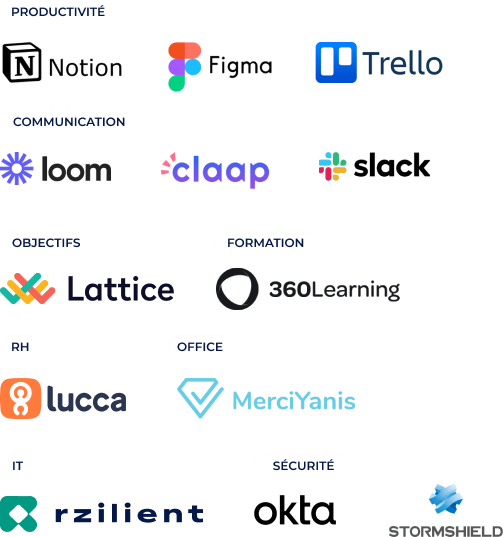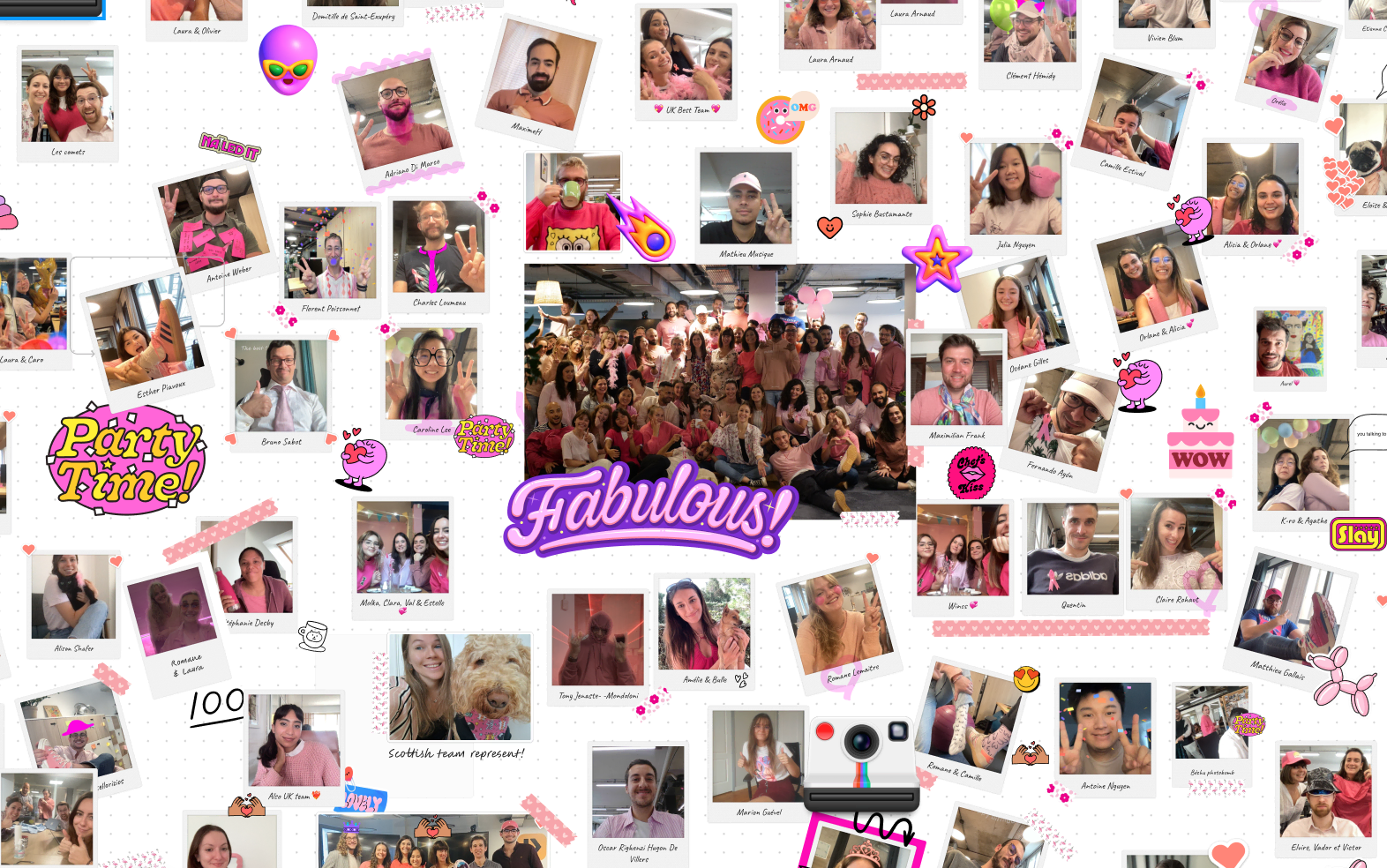7 bonnes pratiques pour gérer le flex et remote office en tant qu’Office Manager

Découvrez notre solution tout-en-un
Tu l’as peut-être vu passer cette actu’ de rzilient sur LinkedIn : notre équipe a eu le plaisir de participer au Sommet professionnel des Office Managers, pour sa 7e édition ! 🎉
Que de belles rencontres, d’échanges sympas et riches ! Cette participation a aussi été pour nous l’occasion de faire découvrir de nouvelles pratiques, utiles pour l’organisation au quotidien d’un.e Office Manager. Et ce n’est pas tout : nous avons organisé un atelier sur la thématique de l’optimisation de l’expérience employé ! 👏
Trois intervenantes Office Managers au top !
Nous en profitons pour remercier nos trois intervenantes lors de cet atelier, des Office Managers d’exception :
- Laura Floury de PlayPlay ;
- Myriam Berthieu de Worldia ;
- et Clémence Vaucel de la France Digitale.
Elles ont joué le jeu avec brio, ont partagé leur expertise et ont embarqué les participants de l’atelier dans de super interactions !

Laura, Myriam et Clémence travaillent pour des entreprises aux contextes très différents.
Playplay est un logiciel de création vidéo simple et intuitif, qui permet aux équipes communication, RH et aux Office Managers de créer du contenu impactant ! 📹 L’entreprise de 230 salariés est présente en France, aux Etats-Unis et en Allemagne. 40 de ses salariés en France travaillent en full-remote. Playplay a adopté une politique de télétravail encadrée : les collaborateurs qui ne sont pas en full-remote doivent travailler au minimum 2 jours par semaine au bureau.
Du côté de Worldia, opérateur touristique connecté de nouvelle génération, Clémence nous explique que l’organisation est hybride et encadrée. Les équipes techniques, par exemple, sont complètement en télétravail. ✈️
Chez France Digitale (la plus grande communauté de startups et d’investisseurs en France), nous apprenons de la part de Clémence que 3 jours de remote sont autorisés au maximum par semaine. Compte tenu de l’activité spécifique de France Digitale, qui organise des événements de taille importante, une règle complémentaire existe : toute l’équipe doit travailler en présentiel à 100% 2 semaines en amont de chaque événement important ! 💻
Nos trois intervenantes ont partagé leurs expériences d’Office Managers au quotidien et les meilleures pratiques à adopter dans ce métier. Laura et Myriam ont aussi fait un retour d’expérience concernant l’utilisation de la plateforme rzilient pour gérer leur parc informatique. rzilient les aide énormément pour gérer leur organisation en remote et flex office, et leur fait gagner beaucoup de temps !
On en profite pour te rappeler deux chiffres clés, qui soulignent l’importance du télétravail aujourd’hui en France :
- 47% des entreprises recourent au télétravail ;
- et 60% des salariés plébiscitent le remote.
Retour sur les 7 bonnes pratiques présentées lors de l’atelier !
Bonne pratique n°1 : choisis bien ton organisation de travail
La première étape pour booster l’expérience employé dans ton entreprise : choisir le mode d’organisation le plus adapté. 💼
4 principaux modes d’organisation du travail existent aujourd’hui :
- 100% office ;
- 100% remote ;
- flex encadré (nombre de jours de télétravail imposés) ;
- flex libre (chacun fait comme bon lui semble !).
Nos intervenantes insistent sur le fait qu’il n’existe pas de solution toute faite. Au contraire, le choix de l’organisation du travail dépend de nombreux facteurs. 🎛️
Pour choisir la meilleure solution pour ton entreprise, il te faudra prendre en compte les attentes et les droits des salariés en télétravail, puis définir et communiquer des règles précises.
Bonne pratique n°2 : sélectionnes avec soin tes outils du quotidien
Nos intervenantes estiment toutes qu’il est important d’imposer les outils choisis et d’éviter de les multiplier. Si un minimum de cadre, le risque est que chaque salarié installe ses outils préférés sur son ordinateur et que le parc logiciel de ton entreprise devienne ingérable ! 💥
Il faut aussi veiller à ce que tes collaborateurs disposent des outils nécessaires pour se sentir connectés avec leur équipe et qu’ils puissent collaborer efficacement. 📳
Certains outils iT sont cruciaux pour aider les Office Managers à atteindre une bonne gestion de leur travail :
- une plateforme de gestion de parc informatique comme rzilient ;
- un SIRH ;
- et un espace de travail collaboratif (Notion ou Slack).
Côté technique, certaines applications moins visibles sont pourtant essentielles pour que tout se passe bien. Citons par exemple un VPN et des outils de sécurisation des postes de travail.
Myriam, chez Worldia, apprécie Notion et Laura de Playplay utilise l’outil Offishall (gestion de l’espace de travail en mode hybride), qui est utile pour :
- informer ses collaborateurs d’où ils travaillent chaque semaine (à la maison, en remote, chez un client, en congés, etc.) : tout le monde sait ainsi facilement où son équipe se trouve ;
- réserver un bureau lorsqu’on vient travailler dans les locaux de son entreprise.
Pour France Digitale, Clémence précise que toute l’équipe travaille sur Google Drive, ce qui permet un partage permanent et instantané des dossiers. 👏 Slack renforce le dispositif des outils de communication, et des niveaux d’urgence ont été mis en place, pour privilégier le canal approprié pour obtenir une réponse rapidement. Clémence nous alerte aussi sur l'importance d'avoir un bon système de visio, faute de quoi des frustrations et pertes de temps peuvent apparaître ! ⏲️
Ce visuel récapitule les briques logicielles principales pour une entreprise fonctionnant en flex ou en remote :

Notre conseil : Google ou Microsoft 364 pour l’environnement de travail et Slack pour la communication de ton équipe.
Bonne pratique n°3 : rends l’expérience employé positive
Comment s’assurer du bien-être des collaborateurs ? De nombreux facteurs sont indispensables à une expérience collaborateur favorable, et notamment une bonne communication interne.
Pour y parvenir, il faut que tu :
- planifies des réunions régulières (facteur de cohésion de ton équipe) ;
- et aussi que tu encourages la communication informelle, ce qui évite l'isolement de tes collaborateurs. 🥂
Chez Playplay, le dispositif est très complet :
- les collaborateurs échangent en one-to-one au moins une fois par semaine avec leur manager ;
- deux réunions “stand up” d’équipe sont organisées chaque semaine, ainsi que des points “deep dive” pour plonger dans les détails des projets ;
- des meetings mensuels sur l’avancement général des projets sont aussi prévus. 🗓️
Myriam partage quelques-uns des outils déployés chez Worldia. Des enquêtes de satisfaction sont systématiquement soumises aux nouveaux arrivants, suite à leur onboarding. Et avec l’outil Lucca, l’humeur du jour peut être facilement partagée par les collaborateurs, afin de prendre le pouls de l’équipe. Des entretiens hebdomadaires et annuels complètent la panoplie des outils pour maintenir le lien.
Bonne pratique n°4 : soignes ton processus d’onboarding
Nos intervenantes soulignent aussi l’aspect crucial des onboardings. Il est vital que les nouveaux collaborateurs se sentent bien dès leur arrivée, qu’ils comprennent les enjeux et leur mission, pour être efficaces au plus vite.
Et tu le sais sûrement, gérer l’onboarding d’une personne en remote est d’autant plus important du fait de l’éloignement, mais aussi plus complexe. 🙇
Clémence nous présente les deux étapes principales chez France Digitale :
- Un lien Notion est transmis à chaque nouveau collaborateur, avant son arrivée, comprenant les règles liées au télétravail ;
- Les documents liés aux assurances et le courrier attestant de la volonté de recourir au télétravail sont demandés dès que possible.
Myriam, chez Worldia, utilise la plateforme de gestion de parc informatique rzilient systématiquement lors de ses onboardings, pour :
- vérifier et commander le matériel informatique ;
- créer les accès et mots de passe nécessaires ;
- enregistrer les matériels iT et logiciels utilisés ;
- envoyer le matériel iT chez le nouvel arrivant ;
- transmettre les invitations aux réunions d'onboardings.
.webp)
Bonne pratique n°5 : délègues la gestion de ton parc informatique
Les solutions MDM font des miracles pour ton organisation et te facilitent la vie en tant qu’Office manager !
Ils te permettent de contrôler à distance les ordinateurs de tes équipes, pour :
- installer (ou désinstaller) des applications à distance ;
- lancer des mises à jour ;
- t’assurer que chaque ordinateur est adapté et prêt à être utilisé.
À titre d’exemple, Playplay a connu une période de forte croissance en 2021. 📈
Une vingtaine de nouveaux collaborateurs arrivaient chaque mois, fréquemment à la dernière minute !
Toute cette activité générait du stress et de la désorganisation. 😔
Laura avait beaucoup de difficultés à tout gérer, en particulier en ce qui concerne le stock des ordinateurs de Playplay. Et pour ne pas faciliter les choses, l’entreprise n’a pas d’IT manager et Laura n’a pas de background en informatique. La mise en place de la plateforme rzilient a été un vrai soulagement pour elle. 👍 Laura n’a plus besoin que de quelques minutes pour réaliser ses onboardings, et peut visualiser d’un coup d'œil l’état de son parc informatique !

Bonne pratique n°6 : boostes ta culture d’entreprise
Lorsqu’on travaille en flex ou en remote, la culture d’entreprise est un levier puissant pour maintenir la cohésion et la motivation dans tes équipes. Cette dualité entre le travail à domicile et au bureau peut être délicate à gérer, comme l'explore cet article sur Home et Office : est-ce vraiment compatible ?
Pour renforcer la culture de ton entreprise, nos intervenantes ont quelques conseils à te proposer !
Chez Worldia, de nombreux événements sont organisés :
- blind tests et autres jeux ;
- déjeuners en équipe avec la découverte des spécialités d’un pays différent à chaque occasion ;
- une fête de l’été et un événement en fin d’année. 🎄
Du côté de Playplay, Laura organise des mini-activités de team building, au moins une fois par mois : un quiz Kahoot ou encore un Blind Test sur “What the Tune ?”. 🎤
Elle a aussi mis en place un photobooth virtuel. Les salariés peuvent se prendre en photo, qu’ils soient au bureau ou seuls à la maison avec leur chat ou leur chien ! Toute l’équipe peut alors consulter les photos, interagir, commenter et créer du lien, le tout en couleur et de manière très fun ! 📸

Bonne pratique n°7 : ne délaisses pas l’offboarding !
Le départ d’un salarié, autrement appelé offboarding, est un moment clé qu’il faut traiter avec sérieux et organisation.
Si ce n’est pas le cas, tu risques de :
- payer des licences logicielles inutilement ; 💶
- ne pas retrouver les ordinateurs des collaborateurs sur le départ ; 💻
- faire face à des utilisations frauduleuses des données de ton entreprise. 🪕
Avec la plateforme rzilient, tu bénéficies d’une aide précieuse. En effet, au départ de chaque collaborateur :
- les licences s’annulent automatiquement ;
- la réception du matériel est gérée et organisée par rzilient ;
- la réinitialisation des ordinateurs est réalisée à distance.
Laura nous explique le fonctionnement adopté chez Playplay au départ d’un salarié, en utilisant la plateforme rzilient. Elle :
- lui transmet un bon d’expédition, accompagné du processus à suivre pour renvoyer son ordinateur ;
- lui envoie la marche à suivre pour déconnecter son compte iCloud ;
- effectue la réinitialisation sur rzilient, lorsqu’elle reçoit l’ordinateur du salarié ;
- et enfin, elle attribue l’ordinateur au stock, en prévision de son utilisation pour un prochain onboarding !
.webp)
